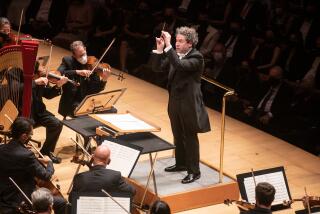Dudamel conducts Stravinsky’s ‘Firebird’ to opulent heights
This story has been updated. See note below.
The introduction to “The Firebird” begins by setting the scene for the green-tongued ogre Kastchei’s enchanted garden, where he houses 13 princesses along with his soul sealed in a giant egg.
There may have been no mildew-green lights licking the stage of the Walt Disney Concert Hall Thursday night, when Gustavo Dudamel began his first performance of Stravinsky’s colorful early ballet score with the Los Angeles Philharmonic, as there had been two nights earlier for Dudamel’s Green Umbrella concert. But this time Disney Hall seemed touched by something far more sensually supernatural.
The opening bars, a kind of musical ladder of repeated triplet figures meant to be played quietly by the cellos and basses, were played so quietly that they were barely perceptible, becoming as much sensation as sound. The effect was that of a weird, unsettling presence in the hall, an ever so slight reality shift.
PHOTOS: Arts and culture in pictures by The Times
And so a few seconds became enough time to realize that Dudamel has a great “Firebird” in him. This had been a worry. No composer is more important to the history of the L.A. Phil than Stravinsky, who lived in Los Angeles from 1940 to 1969, longer than in any other city.
Not only is his music embedded in the orchestra’s DNA, but Stravinsky, long after his death in 1972, helped get Disney built. Fundraising for the stalled hall was renewed in earnest following a revelatory 1996 Stravinsky festival that the orchestra presented in Paris with Esa-Pekka Salonen. Salonen opened Disney with Stravinsky in 2003 and ended his 17 seasons as music director with Stravinsky.
Dudamel, however, has been cautious about confronting L.A.’s Stravinsky heritage. Only last fall, for the opening of his fourth season as music director, did he finally conduct Stravinsky here. That highly anticipated “Rite of Spring” wasn’t quite right, although it certainly had a heavy-duty spring in its viscerally heavy step.
Thursday’s fabulous “Firebird” ended an evening that began with a bizarre rarity — Claude Vivier’s “Zipangu” — and Debussy’s much-loved “La Mer.” A lot was on the line. Dudamel and the orchestra will repeat this program in London, Paris, Lucerne and New York on its upcoming tour later this month. They will also be schlepping Peter Sellars’ staging of John Adams’ “The Gospel According to the Other Mary,” which will first be seen next week in Disney.
Dudamel’s performance of “Firebird” was nothing like Stravinsky’s own performances of the ballet. Dudamel used the original 1910 score, which asks for what the composer later described as a wastefully large orchestra (the L.A. Phil will not be pinching pennies on this tour). But it was one that also allowed Stravinsky to experiment with some of the most brilliantly colorful orchestral effects that had ever been imagined an orchestra might produce.
In a recording of the ballet that Stravinsky made in Paris in 1928 and 1929, the composer emphasized tonal austerity and extreme rhythmic propulsion, tying “Firebird” into the revolutionary “Rite” that came three years later. Dudamel did the opposite. His “Firebird” was opulent. He savored every detail and produced a pleasure for the senses that was heavily weighted on atmosphere.
For all its splashy effects, much of “The Firebird” is delicate. Stravinsky set new standards for descriptive ballet music, and Dudamel made the little things matter. There was exquisite solo playing all through the orchestra — from all the principal wind players, from concertmaster Martin Chalifour and cellist Robert deMaine. The principal horn Andrew Bain is quickly becoming a new star of the ensemble and got a huge hand when he was asked to stand at the end.
There was all the big stuff as well. The most wildly forward-looking music in “Firebird” is found in Kastchei’s “Infernal Dance.” Even here, though, Dudamel seemed more intent on the possibilities of spinning the orchestral color wheel than re-creating the pagan excess of his “Rite of Spring” last fall.
“La Mer,” on the other hand, was unusually, inexplicably, massive. Although this score was also a first for Dudamel in L.A., he recently recorded Debussy’s orchestral evocations of the sea with the Vienna Philharmonic, and he seemed still stuck on a lush Viennese tone. The climaxes were shattering, this being no ocean that any reasonable Angeleno surfer would go near. Perhaps the waves will settle down on the road.
Vivier’s 15-minute opener, for a dozen strings, is a stunner. It is particularly interesting that Dudamel will be taking this to Paris, where the 34-year-old Canadian composer was stabbed to death on the mean streets in 1983 just as his career was taking off.
The strings are not meant to sound beautiful but scratchy and strange. They produce drones that have the character of fingers scratched on a blackboard and melodies that might be chants filtered by NASA from outer space.
[For the Record, 12:45 p.m. Mar. 2: A previous version of this story incorrectly stated Saturday’s performance was at 8 p.m. It is at 2 p.m. ]
-----------------------------
Los Angeles Philharmonic
Where: Walt Disney Concert Hall, 111 S. Grand Ave., Los Angeles
When: Friday (Casual Fridays without the Vivier) 8 p.m., Saturday and Sunday, 2 p.m.
How much: $23.75 - $189.00
Information: (323) 850-2000 or https://www.laphil.org
MORE
INTERACTIVE: Christopher Hawthorne’s On the Boulevards
Depictions of violence in theater and more
PHOTOS: Arts and culture in pictures
More to Read
The biggest entertainment stories
Get our big stories about Hollywood, film, television, music, arts, culture and more right in your inbox as soon as they publish.
You may occasionally receive promotional content from the Los Angeles Times.







